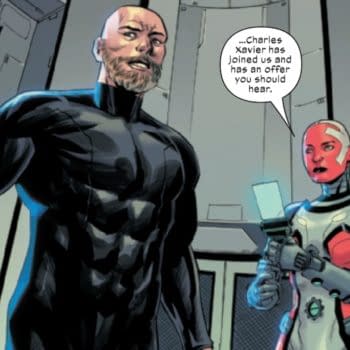Posted in: Comics, Recent Updates | Tagged: dark horse comics, matt kindt, mind mgmt, Mind MGMT Vol. 1, Mind MGMT Vol. 2, Mind MGMT Vol. 3, spies
Bigger Than An Atom Bomb – Chaos In Mind MGMT Vol. 3
It's uncanny how many conversations I've had about Mind MGMT by Matt Kindt that start and end with a wide-eyed, enthusiastic nod, just a few words about how "amazing" and "detailed" it is, a kind of projected count of how many issues are left, a little smile, and that's it. What I mean by that is that Mind MGMT is a wildly successful and popular series, and has been just about from its first issue onward, but people find it very difficult to talk about. That's ok. The most important thing to me, as a fan, is that people are reading it, and in ways not yet fully realized, it's mining its way into the comics psyche for far-reaching effects in how people think about and create comics in the future. I can live with that deal.
I myself haven't done a lot of reviewing when it comes to Mind MGMT. That's not because I've been willing to settle for the semi-conversation of shared enthusiasm and wonder that ends there, but because more than any other series I'm reading lately, I really feel the need to get my hands on a collected edition, almost to check up on myself and see if my initial impressions were solid enough to bank on or if I'm wildly misinterpreting anything (though I think from taking with Kindt in the past that he wouldn't mind if people did. That's somehow part of the whole experience).
So, to start with, I was settling in to write about Mind MGMT in its early days in 2012 and quickly got snapped up onto the academic track to write what I so far believe to be the first published scholarly article on Mind MGMT. It appears in the soon to be released volume: James Bond and Popular Culture: Essays on the Influence of the Fictional Superspy, edited by Bleeding Cool's own West Coast Correspondent Michele Brittany. As I was writing what turned into a fifty page discussion of the ways in which the psychological aspects of Mind MGMT reflect our current reassessment of the Cold War, the second volume of Mind MGMT came out from Dark Horse. I hesitated for about five minutes, then typed "Part II" at the end of my research piece, hit the space bar and went to the comic shop. I knew I couldn't just allow the second volume not to be included in the discussion when it had so much more to add, and once again, I wanted to see that collected edition to make sure I really had seen what I'd seen when reading the single issues (It's that kind of book).
But with that book chapter nicely tucked away and beyond my editing reach (thanks Michele for protecting me from myself in that regard), Volume 3 was released in May of 2014. I knew I needed to get my hands on that, too, but in the course of my life, whenever it occurred to me to do so and I went into a comic shop with finding the book on my mind, it was sold out. Three different comic shops in three different cities over a three month period. I was getting pretty annoyed by this, but too disorganized to order it online. It took on the mythical proportions of Meru's reputed second book in my mind—always slipping away from my reach.
Well, finally I seized the only copy in my region last weekend and read the whole thing cover to cover. If you're reading this you probably already know that reading a Mind MGMT book cover to cover means reading it sideways, upside down, and often in multiple readings per page. I did that too. It's almost a book that precludes the use of furniture because of configuring yourself in constant shifting to read it fully. And by the time you've read the marginalia, you want to read the "main" narrative again to make sure you've processed how they might directly or ironically interact.
I'm going to be unashamedly wordy in this reader-narrative, so if you're losing patience I don't blame you, but it's only honest to tell you that there's more to come.
I will eventually get to the content of the volume, but like the narrative of Mind MGMT finding those demarcation points between subject areas is nigh impossible. I mentioned earlier that people I've tried to discuss Mind MGMT with don't easily find the words to do so, but they also perhaps don't feel the need to do so. Pondering this, I've come to the conclusion that in a medium we tax to supply us with experience, Mind MGMT is one of those comics that goes above and beyond. The synchronous use of psychology on the reader at the same time as the theme of the book is about psychology and the mind is not lost on me, and this helped me choose the subject of that scholarly paper mentioned above. Already, it's hard to move further with language to explain what this comic actually does to the reader and how it changes page by page with varied effects on you.
What exactly does it do? Mind MGMT itself is probably worthy of some kind of quantifiable sociological experiment trying to map the brain while subjects are reading it. Comics already need more of that, in my opinion, and of course there are many theories about what the brain does when reading comics that make it such an important medium, implementing both the right and left sides of the brain at once for a broader and more integrated experience of story. I'll jump into the realm of outrageous speculation and suggest that Mind MGMT not only does this, but moves with a greater degree of rapid alternation between the two, and as the brain works harder and more quickly, we receive a more immersive storytelling experience. Out of our comfort zone and somewhat bewildered by this, we nevertheless know that this comic is somehow communicating more directly with our brain than other works of fiction in any medium.
Consider that possibility and then place alongside it the fact that Mind MGMT is the work of one person. I don't say that to flatter Matt Kindt's genius, though he certainly possesses genius, but to shine a light on the cold hard fact of the immense and painstaking work he does to create Mind MGMT. I was amused and delighted by the detailed work in Volume 1, but by the time I reached Volume 3, I was a little horrified for his sake. I then noticed, paging through the back matter in Volume 3 that he created an alarming array of variant covers for those issues (#13-18) as well.
"Why, sir", I want to ask Mr. Kindt, "Do you feel the need not only to create one of the most elaborate interlocking plot structures we've ever seen in a single series with a massive cast of characters spanning as much as 50 years upon a multi-genre canvas, and then also write novels, nursery rhymes, and atemporal related moments in cartoony style in the margins?" Kindt once said at a panel I attended that it came from having to produce comics himself on secretly used office printers and expensively at Kinkos, leading him to use the margins fully in a comic due to thriftiness and perhaps angst. And thus, I suppose, a monster was born. But I'm going to choose, just for a few moments, to interpret this differently in the context of the contents of Volume 3. The extra material in Volume 3, whether Kindt fully intended it or not, has a strangely emotive quality when juxtaposed with the idea of losing ones memory and receiving your own life narrative second-hand.
When you've lost your life by losing your memory, wouldn't you use every tool necessary to bring it back again, and would you then reject any tiny fragment as unimportant? To get a little English 101 for a moment, let's remember that there is no fixed narrator in Mind MGMT who can give us a single perspective and clear up all the messiness of mental breakdowns, mental erasures, a definitive take on the lives and origin stories of characters. That, of course, is on purpose. This is a story about mental fragmentation and the richness of a broad canvas and, if we're honest, this is a story about chaos. No one knows how to clean up the mess of the Mind MGMT agency, everyone is somewhat infected by the chaos of its creation and aftermath, and to differing degrees they quarantine themselves, other agents (here in Volume 3 the "sleepers" particularly) and observe others messing about in the chaos from a distance, speculating what greater chaos is going to break loose because of this. If there is any antithesis to this massive, world-embracing chaos, it is somehow Meru, which explains why she keeps taking small steps backward, hoping no one will stop her. She senses distance will somehow achieve something. If she wrote her second book, of course, codifying this narrative, essentially, she would be the bringer of some kind of order.
I don't think it's a stretch to point a big red arrow, metaphorically, at the recurrent phrase in this volume's chapter 18, where we encounter the animal-sympathetic Ella again, of "Disaster Area". The issue is ostensibly framed in tropes from children's books, various systems of reference included, and so things in Ella's depicted childhood narrative are labeled, in neat contrast to the images, with extra information. It's at this kind of point when reading that I realize even more fully Kindt's strengths as a storyteller since he uses both "ironic counterpoint" in text and also "multi-perspective narrative", which Alan Moore cites as revelations in his youthful days of comics creating, things that enabled him to change the way people viewed comics. Kindt's got both down pat and quietly moves on to confusing us as much as possible. I note "Disaster Area" because it's repeated. There is plenty of repetition in Mind MGMT but not so usually close together. Things are repeated from differing perspectives over large stretches of page distance. For me, seeing that phrase repeated became thematic.
Volume 3 is a total disaster area. It's an emotional, brutal segment of the story because it forces the reader and characters to confront the past. We "see" things that we were more or less spared in the narrative thread of Volumes 1 and 2. And that's necessary because this volume is about retrieving the past, reconstructing memory, and the dangers thereof. The past becomes more of a disaster area than we thought it was. The present becomes a mine-field in the eruption of repressed memory and tendencies. Until that grand moment, which can't fail to strike a sudden feeling of relief and amazement in the reader, when Meru essentially says "enough" and takes control of the whole story. She's going to impose order somehow, and the intention is enough to make her seem rather god-like. I'm referring, of course, to the end of chapter 17 (issue #17) when Meru's previously seen goddess-like aspect begins to emerge after Matt Kindt's biggest expression of chaos in the series in his double accordion fold-out spread of suburbia being torn apart (bigger even that Zanzibar in terms of dimensions and artwork).
When you take the entire arc of Volumes 1, 2, and 3 in hand, you see that, in fact, the chaos has been building to this moment, while there were other important cruxes to think about. This is the emotive pitch of the discord. To be humorous for a moment—if Meru hadn't made this transition at this point in the comic, we could easily imagine Kindt drawing page after page of destruction for the rest of the series (He may yet, but it'll no doubt be variations on a meaningful theme).
What does this have to do with losing your memory and receiving it back second-hand? Obviously, that's going to make you a little miffed with whoever is responsible for this process, and so there's the deep-seated rage of Volume 3 that crosses through many characters. In fact, let's put a pin in it and say that the rage of the effects of Mind MGMT on its agents (and the related Russian organization) may have been building throughout these first three volumes, too, and this is its clearest evocation, a final eruption. There are so many intriguingly well-crafted turns and reveals in this volume that I don't mean to ignore them in this discussion.
Many of them center on the life and times of Agent M. and one of the "sleeper" planted housewives Megan who feels "forgotten" as she starts to "wake up" wreaking havoc with her domino-powers in a suburban neighborhood. They both as demi-Merus, opposite number women. Agent M. also grew up with books, specifically a kind of science fiction (more Lovecraftian? More futurist?) and through what seems like a series of events that amount to predation, used by Mind MGMT, victimized in her memory by her pseudo-novelist husband, she begins to be both a hollow person, and the world around her becomes hollow due to missing memories and altered perception. This erupts in either catastrophic violence from her, or a set-up that makes it look that way. Presumably, now working for the Immortals, she's attempting to get some kind of closure for what happened to her.
We can contrast this with the account we get from Lyme of Meru's deterioration as he wipes her memory again and again (a re-telling of events from his perspective already told through Meru's in Volume 1). Meru's visit to the library at Shangri-la helps her regain a degree of selfhood, though second hand knowledge of her story then has to be shored up through recovered memory. Presumably, and based on her narration, Agent M. may never recover what was lost. The rest of her story remains to be told.
Megan, having been too long a sleeper, becomes a time-bomb and a specific necessary of the chaos created by psychic spying. Or more specifically through the total lack of ethical boundaries contained therein. Well, one might say, she becomes like Lyme, who destroyed Zanzibar, in her own potential for destruction. Could Meru have turned out like her if Lyme had left her "sleeping" or in a memory-loss loop? It's hard to say—her powers are different. But one thing about Meru is that she recovers fragments of her memory on her own and trusts herself to find them, exemplified in her tin soldier recovered. The narrative becomes muddled for both Agent M. and Megan, and things can only continue to fall apart with catastrophic consequences.
I'll make one more elaborate claim about Mind MGMT before signing off. And that is: this book is about the Cold War in some significant ways, and at the heart of the Cold War was fear of the atom bomb. Splitting the atom and ending worlds. Mind MGMT, at least in my interpretation, is about splitting the psyche. Even the psyche of one agent, it seems, when split, unleashes utterly terrifying forces of destruction. Did they even need an A-bomb to create the destruction in Zanzibar? Meru's survival of this potential splitting seems based upon her unique powers. Agent M and Megan are not so lucky. Neither is Lyme. The Mind MGMT agency had little clue of the destruction they were unleashing through trying to manipulate these gifted people with their protocols, and the full extent of their fall-out is still being mapped in the pages of Mind MGMT.
Hannah Means-Shannon is EIC at Bleeding Cool and @hannahmenzies on Twitter. Appropriate to a discussion of "chaos", she wrote this is in a car, a coffee shop, and standing in her yard while workmen ripped her house a part. She really needs an office. That's not being ripped apart by workmen.
























